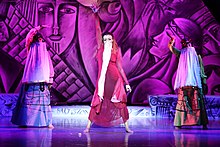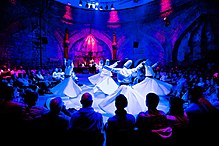Arab folk dances
When the Umayyads conquered Spain, they sent Basque singers and dancers to Damascus and Egypt for training in the Middle Eastern style.
[10] During the French campaign in Egypt and Syria in 1798, Europeans were interested in the Arab world, folk dances and music of each country.
In the middle of the 19th century, the eastern side of the Arab world; Arabia, Egypt, the Levant and the Mesopotamia were collectively referred to as 'Al Sharq' or 'Mashreq'; meaning 'East'.
The Middle East attracted European painters and writers described as Orientalists, who specialized in Oriental subjects; among the most prominent personalities are Jean-Léon Gérôme, Eugène Delacroix and Jean-Auguste-Dominique Ingres.
[11] Arabic dance was performed in the United States in 1893 at the World's Columbian Exposition, which included an exhibition entitled "The streets of Cairo".
The exhibition was attended by dancers from Egypt and several other Arab countries from the Middle East and North Africa, including Syria and Algeria.
In his memoirs, Bloom states, "when the public learned that the literal translation was "belly dance", they delightedly concluded that it must be salacious and immoral...I had a gold mine.
[19] Shamadan (Arabic: شمعدان) is a large candelabrum balanced on top of a dancer's head, in a tradition unique to Egyptian dance.
This is the official moving of the bride and is led by a dancer, musicians and singers, followed by the wedding party and their friends and family.
[24] Raqs Sharqi (Arabic: رقص شرقي) is the classical Egyptian style of belly dance that developed during the first half of the 20th century.
[25] Baladi (Arabic: بلدي) means "of the country" and is a style of Egyptian folk dance from the early 20th century which is still very popular.
Thus, ‘Egyptian Beledi’ means ‘of the country of Egypt’[26] It came about when farmers moved to the city and began dancing in small spaces.
[33] Those dances are performed during the civil celebrations or events as birth, death, wedding or a social ascent and sometimes during religious festivals.
[14] Dabke (Arabic: دبكة), is a Levantine folk dance event forming part of the shared sociocultural landscape of Jordan, Palestine, Lebanon and Syria.
[34] Twice, Dabke was made into a fixed canon of movement patterns and steps which, through repeated execution, served to consolidate behavioral norms and cultural meanings.
[35] Deheyeh (Arabic: الدحية), Is a Bedouin dance practiced in Palestine, Jordan, northern Saudi Arabia, some of the Gulf states, the Syrian desert.
Khaleegy is a joyful, lively, expressive, gestural and delicate dance performed in events involving happiness and celebration (like weddings).
The dance is performed with two rows of men opposite of one another, each of whom may or may not be wielding a sword or cane, and is accompanied by drums and spoken poetry.
It was so named because its purpose was to publicly display the fighting strength of a tribe and boost morale before an armed engagement.
It is an erotic women-only dance, originally performed for the bride before her wedding, with the idea of teaching her how she would be expected to move in the marriage bed.










